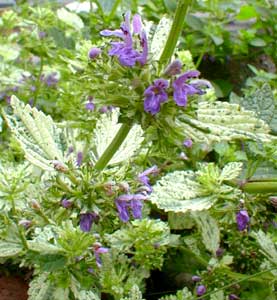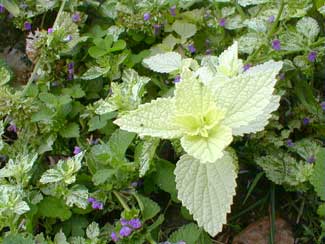
Archer's Variegated
Black Horehound
"There through the long, long summer hours,
The golden light should lie,
And thick young herbs & groups of flowers
Stand in their beauty by."
-William Cullen Bryant
(17941878)
(17941878)
The June (2004) end photograph shows Ballota nigra 'Archer's Variegated,' or Variegated Black Horehound, flowering in a sunny alley-side garden. The lavender-purple flowers persist June through September, though it is not so much grown for the blooms as for the attractive cream & white wrinkly foliage.
The second photo is from September & shows a section of leaves that is completely white. The spreading semi-creeping clump also sometimes produces all-green leaves without variegation, which I remove if I notice, on the off-chance that it might revert to normal if non-variegated leaves were permitted. But I never trim the white leaves it produces as they add something almost fabular, for with none of the green of chlorophyl, how do these all-white leaves photosynthesize?
It thrives in dryish areas in full sun with just a little protection in the hottest days of summer. It is not quite as drought tolerant as White Horehound (B. vulgare) or Greek Horehound (B. pseudodictamnus ); if conditions become too droughty it will not show itself to best advantage.
As a semi-evergreen, it lends to the late-autumn & early winter garden a nice splash of color when other perennials are dying back. It will neverthless look scruffy by winter's end & requires shearing before new spring growth.
 The regular wild form of this species grows as a weed in Great Britain, Europe, & North Africa. In North America it has proven to be invasive in some east coast states, though the variegated version is more restrained, though still very hardy.
The regular wild form of this species grows as a weed in Great Britain, Europe, & North Africa. In North America it has proven to be invasive in some east coast states, though the variegated version is more restrained, though still very hardy. Black Horehound seems not to be a particularly popular garden plant, perhaps because it can sprawl in an untidy manner. Or it might be avoided because of a reputation for having an odor like sweaty armpits, for which reason it is often called Stinking Horehound. But I gave these variegated leaves a good roughing up & it has only a mild, pleasant pungeance. The truly stinky variety would be the weedy B. nigra foetida. Variegated horehound should not be avoided for fear it might smell bad.
It's bad reputation may also derive from ancient, half-remembered superstitions that gave it to be called "Black." White Horehound was named for the Egyptian God of Light, Horus, hence was called not only Horehound, but also Seed of Horus, the plant having sprung from the god's semen. This by implication makes Black Horehound Horus's dark jackal-headed uncle, Set. These two gods represented the Seen & the Unseen, the External & the Internal, & divided among themselves rule of Upper vs. Lower Egyptū.
Due to their divided natures, Horus & Set waged war against one another, in a myth with parallels to the War in Heaven of Jewish & Christian myth. It cannot be coincidental, then, that Black Horehound's second most common name is Black Archangel, vis, Lucifer, while Ballota vulgare is called White Archangel, vis, Michael, who cast Lucifer from heaven. Black Horehound as Lucifer's herb is thus the herb of sorcery & occultism, whereas White Horehound was believed to have the ability to repel spells cast against a household.
The former name of B. nigra was Marrubium nigrum. Marrubium is a name that dates back to Roman times, & some believe it to allude to an ancient Italian village, Maria urbs, where Horehound may well have been sacred to the Virgin Mary, & to Rome's Magna mater before Mary, "Black Mary" being a form of Mary derived in great part from Cybele (hence the numerous Black Mary images throughout Europe show her sans child). However, it is more likely that the name Marrubium was derived from the Hebrew marrob meaning "a jug containing a bitter juice," & reiterates the Egyptian context.
Both white & black horehounds came to be regarded as the horrid-tasting herbs which Jews in captivity were required to feast upon during the last & most horrific Plague against Egypt, & for all Passovers to follow. This makes a wonderful sense in the Yahwist or biblical context of turning the symbols of foreign divinities against the people who so worship, so that these herbs associated with Horus & Set ended up protecting not the people of Egypt, but their Jewish slaves.
The use of White Horehound for colds & congestion is not generally extended to Black Horehound, but the black does have its own alleged medicinal values. Black Horehound is believed by many to have a mild sedative value when made into a nasty-tasting tea, or treats stomach irritation caused by stress. The leaves used topically relieve insect sting, allergenic itch, or sunburn. Although it is not the horehound from which a syrup is derived for candies or cough syrups, in some cases extracts of black horehound have been used to adulterate white horehound.
It has many chemical components that have in recent decades undergone controlled studies & lab analyses in search of potential medicines. Its phenylpropanoids, for example, appear to have antioxidant & neurosedative properties, while other components may be antimicrobial.
However, to date, the evidence of efficacy of the herb itself is slim, & the potential harm it could do is worrisome. Seekers After Magic Home Remedies would do best to avoid this one. Small amounts imbibed as a mere tea because of a faint possibility of tonic value would not likely be life-threatening, but the exceptions could well be numerous. It may interfer with hormonal balance, sufficient to be dangerous if taken during pregnancy. It additionally interfers with the brain's capacity to process dopamine, which implies a potential for catastrophic side-effects for some people, such as heightening schizophrenia or hastening the progress of Parkinsons disease. It is more generally apt to negate the effects of prescription medications, so one's doctor should be informed if Black Horehound has been injested.
It is fortunately uncommon in the modern herbalist's pharmacopeia. One appalling recommendation I have seen for it was for settling the stomach during morning sickness caused by pregnancy, so herbalists who do recommend it do so even when it is the most hazardous. It would have been nice to believe herbalists have avoided recommending it because of its potential dangers, but the actual reason seems to be its discouraging flavor.